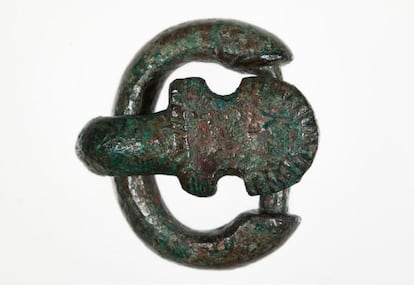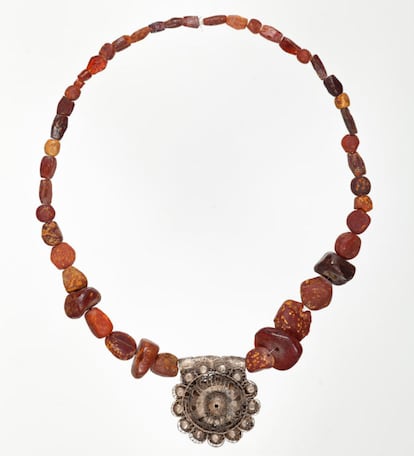Julio Martínez Santa-Olalla was the authentic factotum of Spanish archeology during the first stage of Franco. Everything, absolutely everything, revolved around him. Germanophilic declared, was appointed representative of the government of Franco and Spanish Falange Traditionalist (FET) and the JONS (the unique Francoist party). He visited Nazi Germany to teach some conferences at the Institute of Cultural Morphology of Frankfurt. He was appointed General Commissioner of Excavations (responsible for all Spanish deposits) in 1939 and went to Ahnenerbe, the institute that investigated the Aryan race in Germany. In addition, he was the man who accompanied the genocidal Heinrich Himmler during his visit to Spain in 1940 looking for archaeological pieces that racially and historically unite both peoples. In 1953, he was appointed director of the Madrid Archaeological Institute, precursor of the current San Isidro Museum. The origins of Madrid, where it moved part of its Visigoda collection, from at least two deposits: Castiltierra (Segovia) and Villel de Mesa (Guadalajara).
Martínez Santa-Galla died in 1972. A year later, the State acquired its brothers a part of its pieces, documents and library and transferred it to the National Archaeological Museum (MAN). What was bought were objects that came in a “series of boxes containing materials from excavations”, according to the studyo Visigothic Villel de Mesa site at the National Archaeological Museum, a state of the matterby Paula Pagés Alonso, of the Department of Medieval Antiquities of the MAN. The boxes included materials labeled as “Castiltierra” and “Villel de Mesa”.
In 1999, the MAN technicians reviewed the packaging and made a list of the objects they found inside. The pieces were wrapped in different ways. Some, in newspaper papers, boxes of German photographic and tobacco material, which indicated that they were from Castiltierra, since that site was reopened to observe Himmler. A good part of the hundreds of valuable objects found were sent to Germany for their alleged restoration. Only a minimum part returned.
Other pieces came in yellow paper wrappers inside boxes from a moving company. Some included the number of the tomb in which they were found, others not. As in Castiltierra the tombs were listed – a 420 – and in Villel de Mesa no, the technicians of the museum believe to know which correspond to each site. “In this way, in a preliminary way it is possible to make a separation between the pieces that are Sigradas (numbered and identified) and those that do not, ”says Paula Pagés.
The main problem with the documentation of the excavation of Villel de Mesa is its shortage. A plane of the site is lacking, since there is no memory of the excavation – if some documents that are stored in the MAN – although Miguel López Gordo, neighbor of the town, has managed to collect some information he offers on a website.
In May 1943, while they carried out some expansion tasks of the Municipal Cemetery of Villel de Mesa, an anthropoid sarcophagus (limestone) (limestone) of large size was discovered, a finding that joined other previous ones that had occurred in a casual way when the field, such as graves, bones and various objects. When the sarcophagus was discovered, the mayor contacted the then civil governor, Juan Casas Fernández. This, in turn, warned Santa-Olalla. A letter from the governor on the matter is preserved: “I have been living in the knowledge of Villel de Mesa, it can be some interest as V. supposes; I have already given order to the mayor so that he does not touch there until V. does not go.”

Santa-Olalla contacted the German ambassador to Spain, Hans Heinrich Dieckhoff, and invited him to know the findings. Bernardo Sáez Martín, intimate friend and collaborator of Santa-Olalla, financed the excavations. Archaeologists Ana María Elorrieta Lacy and María Victoria Martín Mendiluce directed them. The residents of the town helped excavation.
Hundreds of pieces were collected, including wooden coffins with iron nail, sarcophagi carved to the toba for children and adults, arriñonadas buckles, belt plates, fibulas, bracelets, slopes, glass and amber accounts or rings. “The majority were bronze, very rarely silver, and exceptionally gold,” according to the archaeologists who intervened. From the excavation, four photographs are also preserved in which a pair of laminar fibulars and a bronze belt brooch are distinguished with the figure of a butcher.
“The lack of information surrounding this site is one of the main problems when investigating its funds. However, through the low bibliography on the matter and the correspondence preserved in the San Isidro Museum (which directed Santa-Olalla himself), we can rebuild the facts that gave rise to excavation,” says Pagés Alonso’s article.
The materials collected in Villel de Mesa were transferred to Santa-Olalla Casa. In a letter that is preserved in the San Isidro Museum, of June 26, 1944, the archaeologist invites, again, the German ambassador to Spain to know the pieces of Villel de Mesa that he has at home before he moves a part to the university city, specifically to the facilities of the Primitive History Seminar of the man. The ambassador never went.
But the seminar was not only Villel’s pieces, but also of Castiltierra, belonging to some of the more than 400 open graves. Castiltierra’s bone remains were sent, on the other hand, to the Anatomical Museum of the University and the trousseau to Ahnenerbe (Berlin). In 1944, Germany returned some objects, but stayed with the most important.
According to the conservatives of the MAN, in 2000 “there was no specific order and the pieces were mixed in wrappers and boxes.” The material of Villel and Castiltierra was finally kept in the MAN in 32 boxes, according to “their capacity, so, despite the fact that the pieces that were in them all came from the Santa-Olalla background, that they were together did not mean that they belonged to the same burial or even site”.
Since June 2023, the Department of Medieval Antiquities of the MAN is inventing the content of these boxes “trying to marry the materials with the descriptions and drawings that were preserved.” It has been possible to document almost all. Once the work is finished, the pieces will be exhibited in the museum, next to the drawings of the archive, “putting these materials in both the materials and the work of the archaeologists (Ana María Elorrieta Lacy and María Victoria Martín Mendiluce) that carried out the excavation, making them known to the public after almost 80 years of their work”.
Pagés concludes his study accepting that, “despite this, it is more than likely that a certain amount of these pieces that entered the boxes 44 to 48 of the Santa-Olalla collection cannot be associated with security to one or another site, so the final phase of review of the materials of these boxes will be SUNDAY as a third group of pieces without a safe origin. ”

